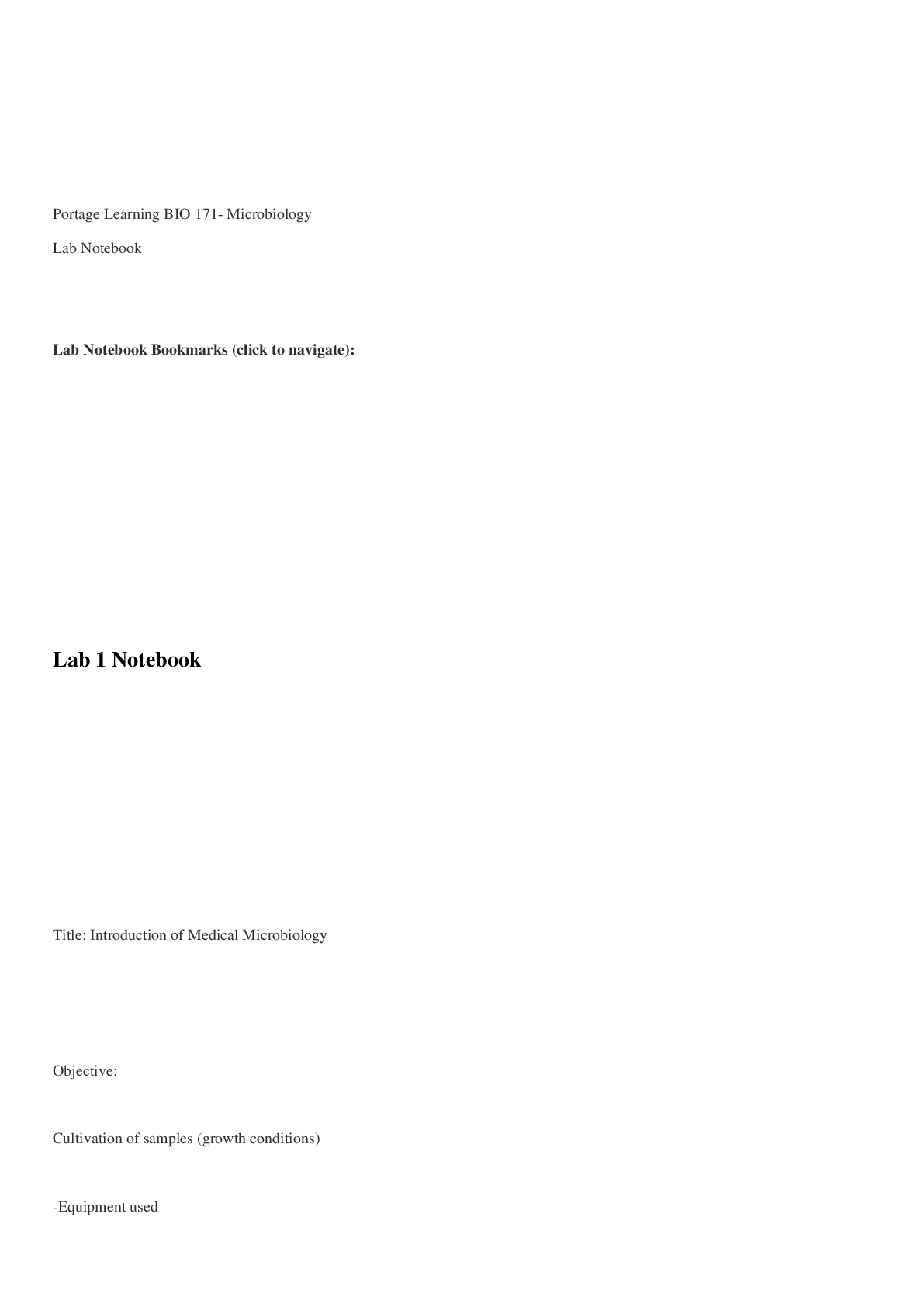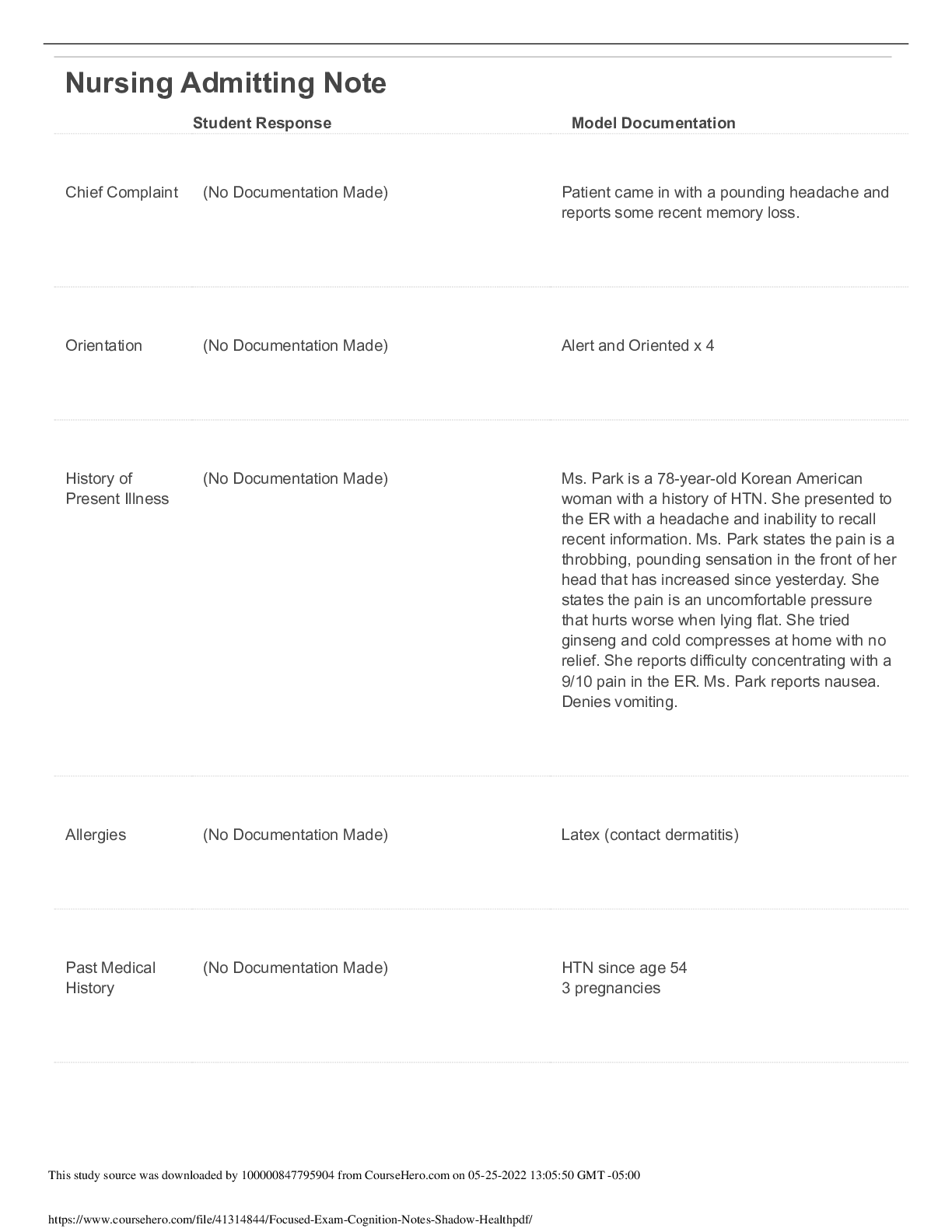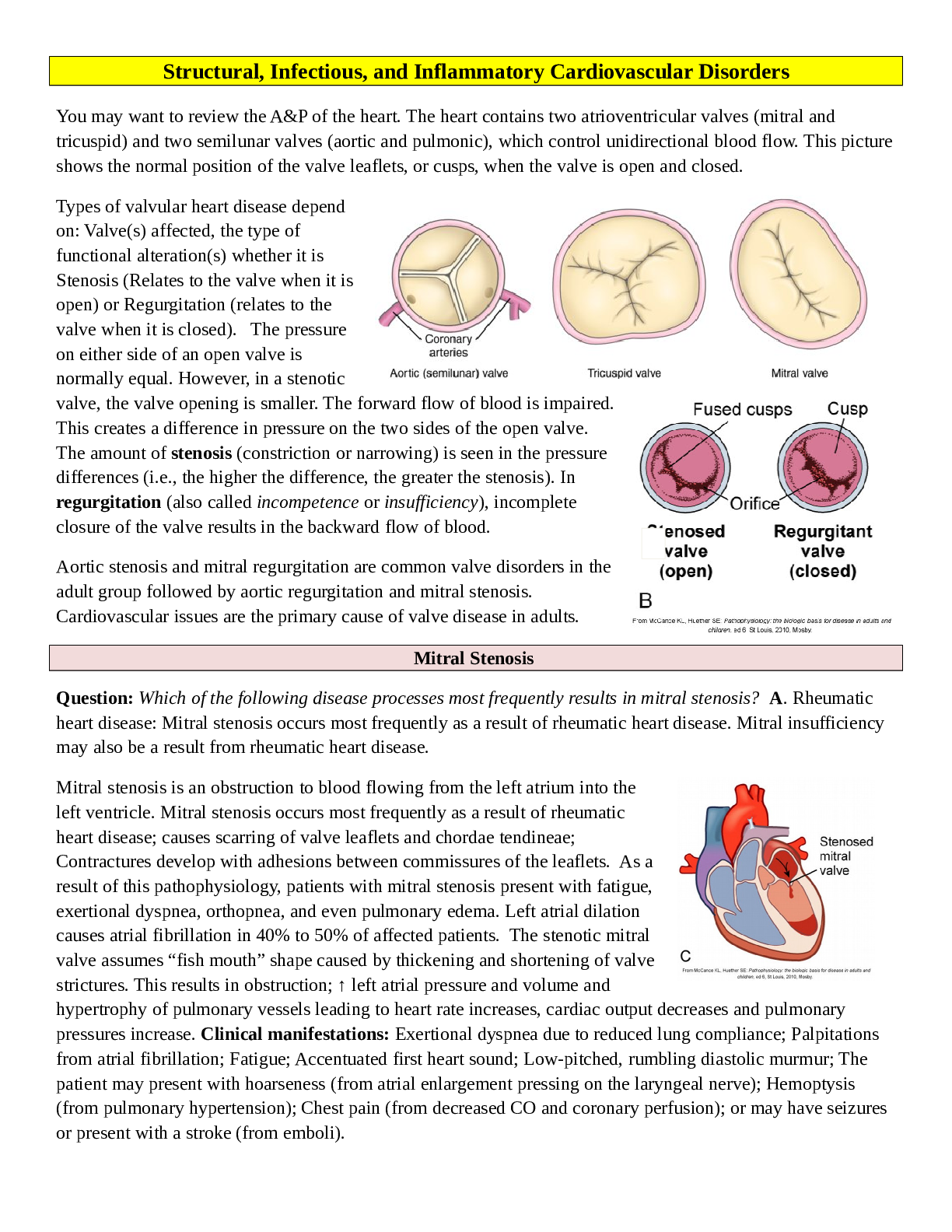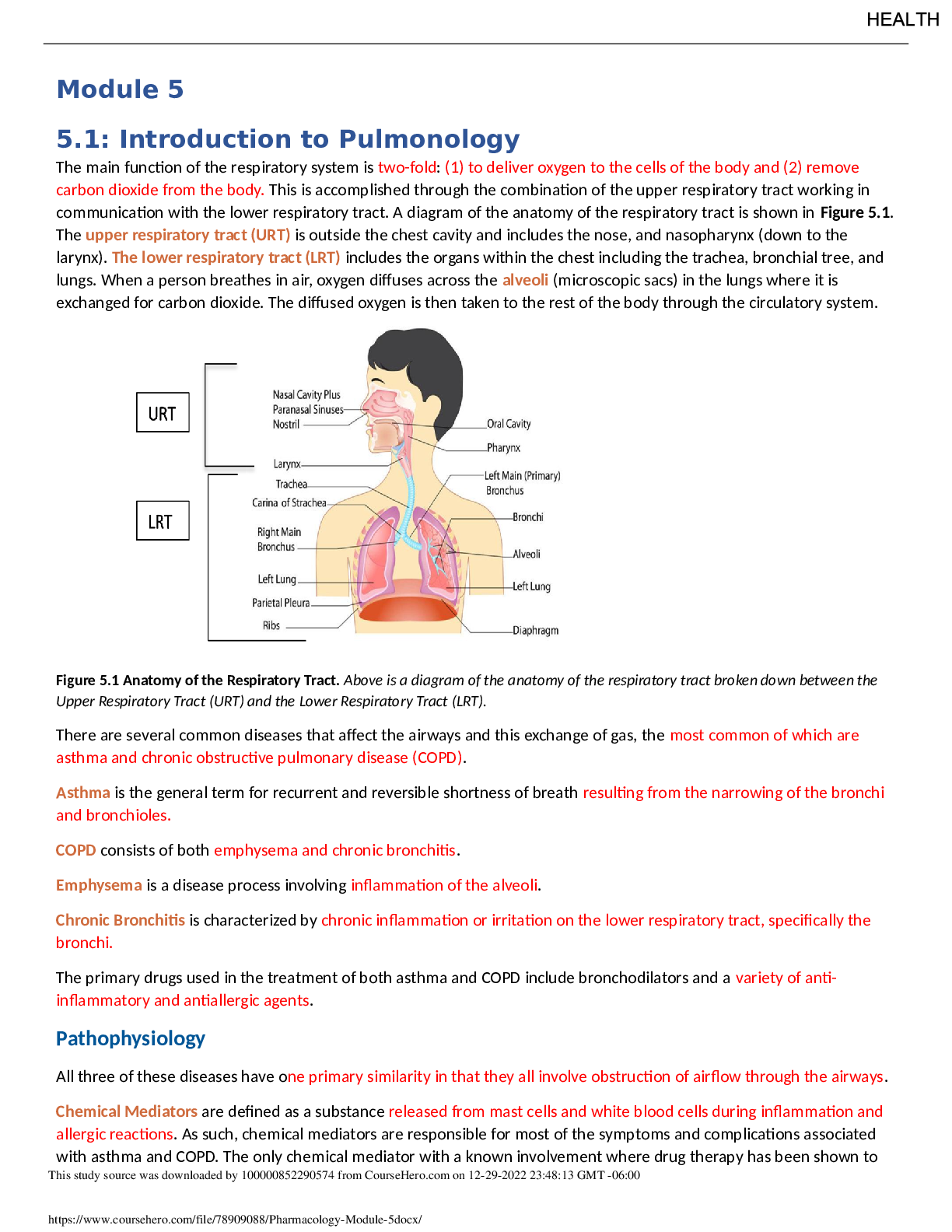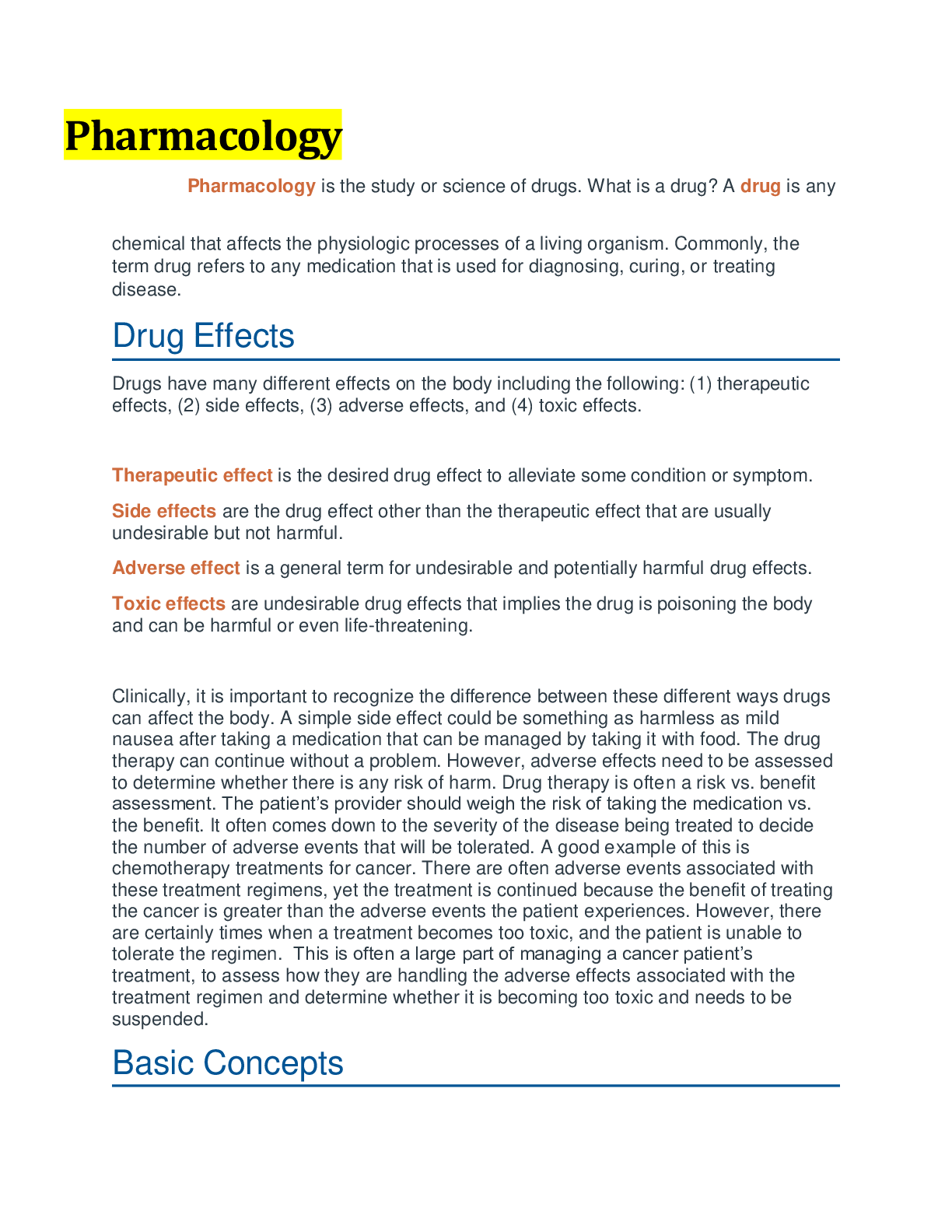*NURSING > Study Notes > NURS 612 N612 A11.2 Neuro notes (Assignment 11.2: Shadow Health Module) (All)
NURS 612 N612 A11.2 Neuro notes (Assignment 11.2: Shadow Health Module)
Document Content and Description Below
Assignment 11.2: Shadow Health Module Submit Assignment ● Due Sunday by 9:59pm ● Points 5 ● Submitting a file upload Points: 5 points Due: Day 7 Directions 1. Use the link wi... thin Module 1 titled Shadow Health Dashboard to complete your modules assigned this week. 2. Complete the Neurological Module in Shadow Health. 3. First document to upload: Your final score from Shadow Health for this assignment. 4. Second document to upload: Word document containing the following information: ○ Synopsis of the Shadow Health assignment. ○ Reflect on your work for this assignment, answering the following questions: ■ What did you learn? ■ How did you grow? ■ How do you plan to improve? Assignment Description: Assess the Neurological system of Tina Jones, a Digital Standardized Patient. Interview and examine the patient, document your findings, and complete post-exam activities. Students spend, on average, an hour and a half on this assignment. During the interview, you will be able to: • Use therapeutic communication to elicit a neurological history and review of system • Conduct a thorough assessment of the patient's neurological system: _ Assess psychological status _ Assess motor function _ Assess sensory function _ Conduct relevant tests • Provide patient education and empathy as appropriate throughout the exam • Report all objective findings in the EHR • Document subjective data in the Provider Notes • Synthesize objective data in the Provider Notes Fecal exam on Tina Jones who is returned to the clinic with a complaint of headaches it has been 11 months since Miss Jones first established Primary Care here at the shadow Health Clinic I miss you will demonstrate your clinical reasoning interview and examine Tina Jones to gather subjective and objective patient data collected condition educate and emphasize to engage in effective therapeutic communication document data accurately using professional terminology after you assess the patient you will answer post exam questions reflect on your experience and then view your results Tina Jones questions and conduct assessments to collect data and uncover findings which you'll report and document in the EHR you will receive a score for your performance and subjective data collection and an objective data collection in this patient exam you should interview the patient to elicit subjective health information about the neurological system select and use the appropriate procedures for a thorough neurological exam report all objective findings in the EHR document subjective data in the provider notes synthesize objective data in the provider notes and assess the patient's risk for disease infection injury and complications as you interview Miss Jones you will have opportunities to engage in therapeutic communication you will also receive a score for your ability to provide education and empathy can access a complete list of instructions at any time during the patient interview by clicking the instructions button located at the bottom of your screen Tina’s three-year-old neighbor presents to the clinic with fever, neck pain, headache, and confusion. He has no symptoms of an upper respiratory infection. The parents mention that they do not believe in immunizations. Based on the information given, what diagnosis is of the greatest concern? What is your next action? The greatest concern for Tina's three-year-old neighbor that presents to the clinic with fever, neck pain, headache, confusion is meningitis. It is likely that if his parents did not get immunization he is more at risk for other types of infections as well. The greatest concern for diagnosis would be meningitis in this case. The next action would be to perform further assessments such as checking for positive Kernig or Brudzinski sign indicates meningeal inflammation and is suggestive of meningitis but is present in a minority of patients. A rash is noted in 80% to 90% of patients, most commonly 4 to 18 hours after the initial symptoms of illness. Typically the rash is a nonblanching petechial or purpuric exanthem, but a minority of patients may initially have nonspecific erythematous macular or maculopapular lesions. Distinguishing between meningococcal infections and less serious conditions is difficult in the early phases of infection, and it may be necessary to begin empiric antibiotic therapy while awaiting results of diagnostic tests. Rapid tests are most useful when it is desirable to individually tailor antibiotic therapy or if identification of a meningococcal infection has immediate public health implications, such as the need to provide antibacterial prophylaxis to close contacts. Cerebrospinal fluid testing or CSF cultures should be considered in patients with signs and symptoms of meningitis. A lumbar puncture (LP) is contraindicated in patients with cardiovascular or respiratory instability, coagulopathy, or infection (including petechial or purpuric lesions) overlying the puncture site. Some experts recommend that LP be deferred in patients with classical presentations of meningococcal disease, as results of this test are unlikely to influence patient management. However, clinical judgment is involved. Deferring an LP is prudent in a critically ill patient with a coagulopathy, but the information obtained by LP in a patient with milder disease may be very helpful in management and outweighs potential risks. Other tests include, a chest radiograph, bone and joint radiography, focal infection tests, nasopharyngeal cultures, and diagnostic imaging like computed tomography (CT) of the head is commonly obtained prior to performing LP in patients with suspected bacterial meningitis (of any etiology) to exclude the presence of a focal intracranial lesion, although there is no conclusive evidence that LP increases the risk of cerebral herniation in this setting. Source: https://online.epocrates.com/diseases/54231/Meningococcal-disease/Diagnostic-Approach Tina’s 83-year-old great uncle forgets where he is during his yearly check-up. He doesn’t remember if he’s had memory problems before and no family members came to your office with him. List your differential diagnosis. What assessments would you perform? Differential diagnosis for memory loss include neurodegenerative diseases such as Alzheimer's dementia, dementia, frontotemporal dementia, and mild cognitive impairment. vascular differential diagnosis include vascular dementia, hypoxic injury after cardiac arrest, ischemic stroke, and hemorrhagic stroke. Infectious and inflammatory etiologies include HIV dementia, neurosyphilis, limbic encephalopathy, and Hashimoto encephalopathy. Traumatic etiologies include traumatic brain injuries and chronic traumatic encephalopathy. Endocrine ideologies of memory loss include hypothyroidism. episodic ideologies for memory loss include seizures, migraines, and transient global amnesia. lastly, the metabolic differential diagnosis for memory loss includes vitamin B12 deficiency and Wernicke-Korsakoff syndrome. Assessments would include investigation of diagnosis is based on a comprehensive history (including rate of clinical progression and initial symptoms), neurologic exam, neuropsychological testing, neuroimaging, and laboratory investigations. A comprehensive history is the first and most essential step of the diagnostic workup of memory loss. As many patients may be unaware of their deficits, reliable informants who interact with the patient on a regular (ideally daily) basis are the key to a complete history. The history will help delineate the time course as well as any pathognomonic symptoms accompanying the memory loss. The rate of clinical progression of memory loss is a helpful clue to understanding the underlying etiology. Acute symptoms (i.e., within minutes to hours) are suggestive of ischemic stroke, hemorrhagic stroke, seizures, migraine, or transient global amnesia. Subacute symptoms (i.e., within days to months) typically occur in infectious and inflammatory conditions, such as limbic encephalopathy and Wernicke-Korsakoff syndrome. Dementia that progresses over weeks to months occurs in Creutzfeldt-Jakob disease (CJD) and Hashimoto encephalopathy. Chronic symptoms (>2 years) are suggestive of a neurodegenerative process or vascular dementia. The second part of the workup is the neurologic exam. Different findings on neurologic examination can be helpful in the differential diagnosis of memory deficit Investigating current mental status, cranial nerve exam, reflexes, gait, and motor exam. It might also be crucial to investigate neuropsychological testing. Source: https://online.epocrates.com/diseases/71021/Evaluation-of-memory-deficit/Diagnostic-Approach Name at least three ways to assess cerebellar function during a physical exam. Three ways to assess for cellular function include observing the patient walking, Romberg test to ask if the patient can stand unaided with their eyes closed with a gentle push and keep standing, test tone in the shoulders, and doing the walk heel-to-toe to assess balance. If Tina had a fever and photophobia, you would have had to test for meningitis. Describe how you would have tested for the Kernig’s sign. Kernig’s sign indicates meningeal inflammation and is suggestive of meningitis. It is elicited by having the patient lie supine and flexing the thigh so that it is at a right angle to the trunk, and extending the leg at the knee joint. If the leg cannot be completely extended due to pain, this is considered positive. Suppose you assessed pain sensation over Tina’s left foot, and noticed that she had decreased sensation. How would you have proceeded with your exam? If Tina's left foot has noticed decreased sensation further investigation would be to assess the other foot to see if that foot also has decreased sensation. Since Tina is a diabetic she is at high risk for diabetic neuropathy which is decreased sensation in the limbs. To assess bilateral Sensations in the feet you would start at the feet and proceed of the legs, sensation tested include sharp and dull to touch, light touch, vibration, point location, temperature, and positioning of either Jones. Next, deep tendon reflexes in the feet should be assessed such as superficial, ankles, and knees, to help determine the extent of neuropathy if any. Explicitly describe the tasks you undertook to complete this exam. To complete this exam, I had to utilize all my resources from my current assessment books and my provided resources from my nursing 612 class. I also used my anatomy and physiology books to look up cranial nerves and necessary neurological assessments. Then I utilize my assessment and differential diagnosis books to help hone what questions, assessments, and ordinary differential diagnoses would be helpful to complete the exam. I also used my notes from PowerPoints and lectures from the nursing 612 class. Explain the clinical reasoning behind your decisions and tasks. I found this neurological module and exam to be very challenging. I had to utilize my critical thinking and decision-making skills that I have learned in seeking common signs and symptoms of illnesses and what differential diagnosis they correspond with. At first, the neurological exam included a headache but later included neck pain as well. Having two different types of pain sources did confuse me a bit. I had to hone in on what types of headaches, the duration, onset, characteristic, location, and current treatments Tina was doing at home. I had to do this per the pain area. after investigating subjective signs and symptoms, Tina provided by Then followed up with an objective assessment to figure out if the etiology was trauma-related, infection-related, or something else. I found it increasingly challenging to hone what the cause could be. Are utilized by critical thinking with subjective and objective data collection to help figure out what I should be focusing on. It was also interesting to see that her neurological exam was comprehensive and particular, which, if there were is anything out of the ordinary, would indicate a specific disease process in the neurological system. Identify how your performance could be improved and how you can apply “lessons learned” within the assignment to your professional practice. I feel I could improve my performance by increasing my logic and knowledge regarding the common etiology of headaches. It seems that problems have so many different ideologies and differential diagnoses that come with that disease process. Especially, neurological deficits that could occur from different types of headache sources such as trauma, infection, or other vascular causes. I need to focus on improving my current knowledge regarding neurological assessments to be able to recognize what diagnostic approach is the most appropriate. Since there are so many types of neurological disorders that include headaches, it is important to hold my assessment skills and questions to help find the differential diagnosis. I plan to focus on the more common ailments when diagnosing headaches if no other significant signs symptoms occur. [Show More]
Last updated: 2 years ago
Preview 1 out of 7 pages

Buy this document to get the full access instantly
Instant Download Access after purchase
Buy NowInstant download
We Accept:

Reviews( 0 )
$10.00
Can't find what you want? Try our AI powered Search
Document information
Connected school, study & course
About the document
Uploaded On
Aug 11, 2022
Number of pages
7
Written in
Additional information
This document has been written for:
Uploaded
Aug 11, 2022
Downloads
0
Views
107

.png)

